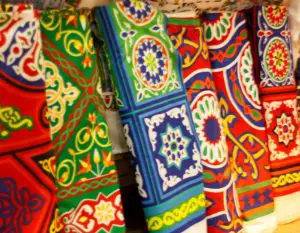As the climate of Egypt is hot therefore the clothing had to be light, cool and non-restrictive. Egyptian clothing (or Egyptian Fabrics) was dictated by the materials that were available in Egypt. They worked outside in the sun all day in the desert area, therefore, they wanted clothes that could keep them cool. Because of the hot and humid climate, they wore little or no clothes at all. fabrics were mostly thin and light.

Types of Egyptian Fabrics
Linen
All clothes were almost always made of linen which is made from flax. Flax, the plant that produces linen threads grew easily in the rich silt soil of the River Nile. Flax was pulled out of the ground, not cut. Half-ripe flax stems made the best thread. If the stems were too ripe, they were used for mats and rope.
Cotton
Cotton was not introduced until the Coptic (Christian) period. White linen needed constant washing. It was washed in the river or canal, rinsed, then pounded on a stone, and, bleached in the sun. Linen clothes needed to be replicated every time they were washed.
Wool
Wool and most other animal products were not popular in ancient Egyptian clothing. The Egyptians believed that the fabric was unclean, and they were never used by the priests. The only exception was the skin of leopards. Animal skins, especially leopard skins were prevalent mostly by priests and Pharaohs while performing their sacred duty. At times kings and queens wore decorative ceremonial clothing adorned with feathers.
The clothes of the pharaohs were more transparent than others to display the wealth and status. A cloth was wrapped around their waist. The usual people wore loin clothes manufactured from animal hide and linen and simple tunic dresses that were fitted. The priests were not permitted to wear Leather sandals or wool clothing as they were thought to be unclean.
The wealthy people both men and women wore long see-through robes that were pleated. Noblemen would sometimes wear a long robe over his kilt, while the women wore long pleated dresses with a shawl. Some kings and queens wore decorative ceremonial clothing with feathers. Wealthy people wore sandals made of leather that had straps across the instep and between the first and second toes.
In Ancient Egypt, women were predominately in charge of textile manufacturing and garment making. Garment making was a household chore, but a woman also worked for aristocrats in spinning and weaving shops. The tools involved in garment making include knives and needles, both of these needed to be molded, shaped or craved. The types of tools used changed over centuries. Needles were made from wood, bone, and metal.